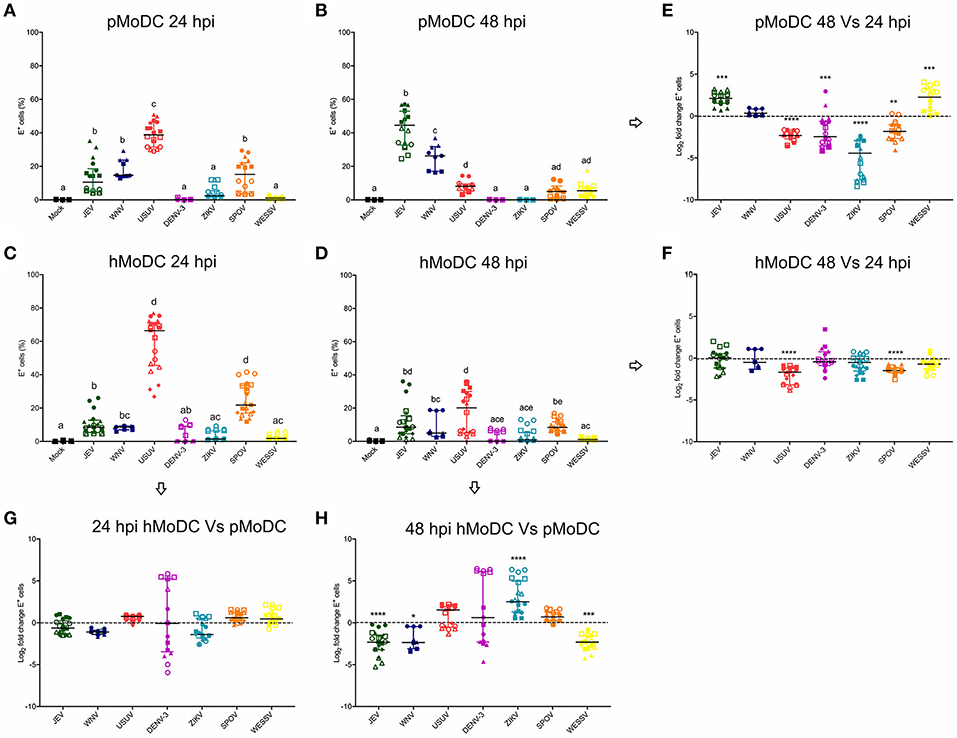Corrigendum: Monocyte-Derived Dendritic Cells as Model to Evaluate Species Tropism of Mosquito-Borne Flaviviruses
- 1Institute of Virology and Immunology (IVI), Bern, Switzerland
- 2Department of Infectious Diseases and Pathobiology, Vetsuisse Faculty, University of Bern, Bern, Switzerland
- 3Graduate School for Cellular and Biomedical Sciences, University of Bern, Bern, Switzerland
- 4Department of Emergency Medicine, Inselspital, University Hospital Bern, Bern, Switzerland
A Corrigendum on
Monocyte-Derived Dendritic Cells as Model to Evaluate Species Tropism of Mosquito-Borne Flaviviruses
by García-Nicolás, O., Lewandowska, M., Ricklin, M. E., and Summerfield, A. (2019). Front. Cell. Infect. Microbiol. 9:5. doi: 10.3389/fcimb.2019.00005
In the original article, there was a mistake in Figure 1. The plots C and F in Figure 1 were wrong and not from hMoDC as they should have been. The corrected Figure 1 appears below. The text of the Figure legends and the article remains unchanged as they describe the correct Figure 1. The authors apologize for this error and state that this does not change the scientific conclusions of the article in any way. The original article has been updated.

Figure 1. Comparative susceptibility of pMoDC and hMoDC to selected Flaviviruses. (A–D) E protein expression in pMoDC and hMoDC after infection with different viruses at a MOI of 0.1 TCID50 per cell. E protein expression was quantified after 24 (A,C) and 48 hpi (B,D) by flow cytometry. (G,H) Relative ability of Flaviviruses to infect hMoDC and pMoDC shown as fold change of infection (E protein positive cells) calculated at 24 (G) and 48 (H) hpi. (E,F) Fold change in infected cells between 24 and 48 hpi, shown for pMoDC and hMoDC, respectively. All experiments were performed in triplicates and repeated at least three, and up to seven times with cells from different donors. Each symbol represents a different blood donor. Results are presented as scatter plots showing the mean and all points. The different superscript letters in (A–D) indicate significant differences (p ≤ 0.05) between the different viruses. Fold change infected cells results are expressed in logarithmic scale of base 2; for each infection condition significant differences between the calculated fold change and the reference level (equal to 0, dotted line) are indicated (*p ≤ 0.05; **p ≤ 0.002; ***p ≤ 0.001; ****p ≤ 0.0001).
Keywords: Flavivirus, monocyte-derived dendritic cells, in vitro model, infection, tropism, innate immune response
Citation: García-Nicolás O, Lewandowska M, Ricklin ME and Summerfield A (2019) Corrigendum: Monocyte-Derived Dendritic Cells as Model to Evaluate Species Tropism of Mosquito-Borne Flaviviruses. Front. Cell. Infect. Microbiol. 9:163. doi: 10.3389/fcimb.2019.00163
Received: 24 April 2019; Accepted: 29 April 2019;
Published: 15 May 2019.
Edited and reviewed by: Alan G. Goodman, Washington State University, United States
Copyright © 2019 García-Nicolás, Lewandowska, Ricklin and Summerfield. This is an open-access article distributed under the terms of the Creative Commons Attribution License (CC BY). The use, distribution or reproduction in other forums is permitted, provided the original author(s) and the copyright owner(s) are credited and that the original publication in this journal is cited, in accordance with accepted academic practice. No use, distribution or reproduction is permitted which does not comply with these terms.
*Correspondence: Artur Summerfield, artur.summerfield@ivi.admin.ch
†These authors have contributed equally to this work
 Obdulio García-Nicolás
Obdulio García-Nicolás Marta Lewandowska
Marta Lewandowska Meret E. Ricklin
Meret E. Ricklin Artur Summerfield
Artur Summerfield